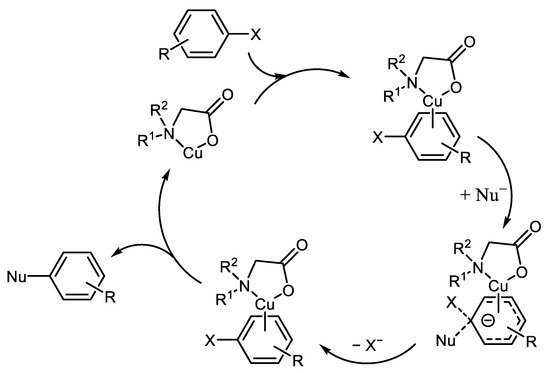Your browser does not fully support modern features. Please upgrade for a smoother experience.
Please note this is a comparison between Version 2 by Conner Chen and Version 1 by Tomáš Weidlich.
Ar-Xs are technologically important inert low-cost solvents (chlorobenzene or o-dichlorobenzene) and intermediates for the manufacture of flame-retardant polymers used in electronics and furniture. Furthermore, Ar-Xs are the chemicals necessary for the production of industrially important dyes, pigments, and a broad group of biologically active species such as pesticides and drugs. Utilization of Ar-Xs as arylating agents based on Cu-catalyzed substitution of bound halogen (X) applying different nucleophiles serves as the technique for production of a broad scale of useful chemicals.
- amine
- amination
- arylation
- halogenated aromatic compounds
1. History and Modern Trends in Cu-Catalyzed Ar-Xs Transformations with Amines
Ar-X-based N-arylation of organic amines or amides (Ullmann-Goldberg reactions) is a widely used transformation in chemical synthesis because it allows access to a wide group of dyes, pigments, and biologically active and/or pharmacologically significant compounds [6,7,8,9].
In 1906, Irma Goldberg published an arylation of aniline with 2-bromobenzoic acid catalyzed by copper [10], Scheme 3Scheme 1.

Scheme 31.
Cu-catalyzed debromination of 2-bromobenzoic acid accompanied by arylation of aniline [
].
Such copper-mediated cross-coupling reactions have many industrial applications, including the synthesis of intermediates and fine chemicals for pharmaceutical and polymer chemistry. However, Cu-catalyzed couplings have not been employed to their full potential for a long time.
Until 2000, the main drawbacks of Cu-catalyzed Ullmann-type C-X coupling reactions between Ar-Xs and nucleophiles were the harsh reaction conditions (several hours at temperature as high as 210 °C), the need for stoichiometric use of copper or its salts and the utilization of polar solvents. According to the requirements of organic chemists, the Cu-catalyzed C-N couplings had poor functional group compatibility and poor reaction efficiency. As a result, Pd-based catalysis achieved major development enabling C-N couplings at even ambient temperature using a catalytic quantity of Pd-based catalyst [11,12,13].
However, taking into account the price of noble palladium and its toxicity, abundant, cheaper and more sustainable C-N coupling catalysts are being sought, such as Ni- or Cu-based catalytic systems [14,15,16,17,18,19,20,21,22].
Both radical and ionic processes were proposed or even proved for Cu-based C-N coupling catalysis involving the effects of Cu(I), Cu(II) and even Cu(III) oxidation states [3,14,16,22].
The mechanism of Cu-catalyzed amination of Ar-Xs is explained most often by oxidative addition (OA) of Ar-X into the LCu(I)-Nu complex producing LCu(III)XAr intermediate. This LCu(III)XAr decomposes via reductive elimination (RE) producing Ar-Nu and LCu(I)X [22], Scheme 4Scheme 2.
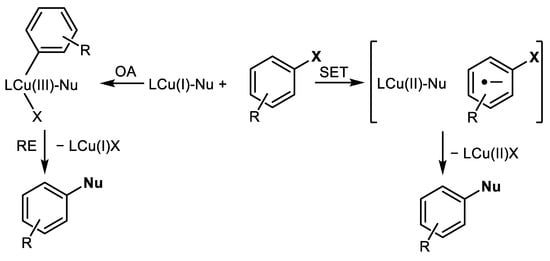
Scheme 42.
Scheme of radical (SET) and ionic (OA/RE) mechanisms proved for Cu-catalyzed C-N cross-coupling [
,
,
,
].
The third, alternative reaction mechanism is based on the nucleophilic aromatic substitution of halogen in π-complex formed from Cu-ligand and Ar-X [23], Scheme 5Scheme 3.
Modern trends in organic chemistry, such as the sustainable chemistry principles, motivate more environmentally friendly methodologies based on the application of catalytic amounts of copper catalyst. This requirement was fulfilled mainly by applying auxiliary ligands for control of the coordination environment of the used Cu-species [24,25,26].
Recently, “ligand free” reaction conditions have been mentioned for the C-N cross-couplings catalyzed by Cu-based compounds [14].
However, with high probability, a used solvent or base may act as a spare ligand in these cases. Guo et al. and Choudary et al. supposed that using a combination of Cu(I) source and K3PO4 as the base or calcium phosphate as the support, the phosphate group is able to chelate Cu(I) which subsequently assisted the oxidative addition to the Cu center [27,28].
Monnier and Taillefer adverted to lower the reproducibility of such “ligand-free” reaction systems in particular by applying scale-up compared with ligand-based reaction systems [14].
Next to used ligands, the solvents have a significant role to play in the overall sustainability of the chemical processes [29].
Green pathways involving reactions performed in biobased renewable solvents, non-volatile ionic liquids, or polyethylene glycols were utilized to replace the harmful, sometimes even carcinogenic, volatile organic solvents produced from crude oil [29,30,31].
Dimethyl sulfoxide (DMSO) is a well-known non-toxic polar aprotic solvent produced from a by-product of the papermaking industry, dimethyl sulphide. DMSO is a green replacement for harmful amides such as N-methylpyrrolidone (NMP) or N,N-dimethylformamide (DMF) used as common polar aprotic solvents [32,33].
However, it must be mentioned that the application of DMSO is not compatible with a variety of copper salts, halides or bases at high temperatures which can cause decomposition of DMSO and pose a potential explosion hazard [34].
2. Cu-Catalyzed Substitution of Halogen in Ar-Xs with NH3
Simple amination of aryl halides using ammonia catalyzed by Cu(I) was extensively studied using polar aprotic (DMF or DMSO) or polar protic (EtOH, ethylene glycol, polyethylene glycol) solvents, different bases (Cs2CO3, K2CO3, K3PO4) and a broad spectrum of ligands (Figure 1) [35,36,37].
The published Cu-catalyzed methods applied NH3, NH4Cl, NH4OH, acetamidine, amices or amino acids as a source of nucleophiles, in addition to different types of ligands (Figure 1) or even ligandless procedures [38,39,40,41,42,43,44,45,46,47,48,49,50,51,52,53], see Scheme 6Scheme 4 and Table 1 and Table 2. In most cases, only aryl bromides and iodides are applicable for Cu amination. Aryl chlorides are quite inert toward this type of Cu-catalyzed cross-couplings in most cases [35,36,37,38,39,40,41,42,43,44]. The most effective oxamide-based ligands, N-(naphthalen-1-yl)-N-alkyl oxalic acid diamides (MNFMO or NFMO), were found to achieve high turnovers (complete C-N cross-coupling with only 0.1 mol.% Cu2O and ligand) [44]. These ligands achieved 10,000 turnovers in cases of cross-coupling aryl bromides and iodides with ammonia [44].

Figure 1.
Structures of ligands applicable for converting aryl halides to the corresponding anilines [
,
,
,
,
,
,
].
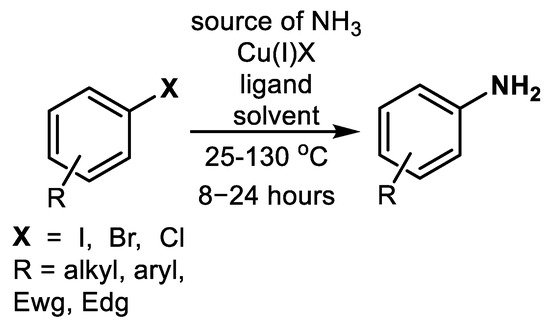
Scheme 64.
Amination of aryl halides using NH
3
or its different sources [
,
,
,
,
,
,
,
,
,
,
,
].
Table 1.
Cu-catalyzed amination of (hetero)aryl halides using NH
3
, NH
4
Cl, acetamidine or valine.
| (Hetero)Aryl Halide (Ar-X) | Added Catalyst | Added Ligand (mol.%) | Base/Solvent | Reaction Conditions | Yield (%) | Ref. |
|---|---|---|---|---|---|---|
| Bromopyridines or iodobenzene | Cu2O or Cu/CuCl (0.5 wt.%) |
no | 8 M NH3 in HOCH2CH2OH | 80 °C/16 h in autoclave flushed Ar | 62–99 | [38] |
| Subst. 2-bromopyridines | Cu2O (2 mol.%) |
no | HOCH2CH2OH saturated with NH3 | 100 °C/24 h in autoclave | 54–82 | [39] |
| 4-bromo-acetophenone | CuI (equimolar quantity to substrate) or Cu powder (20 mol.%) | no | 27 wt.% NH3 in H2O + 6 M NH3 in HOCH2CH2OH (3:5) | flushed with N2 85 °C/8–12 h (0.3–1.2 MPa) | 77–86 | [40] |
| Subst. Bromo- and iodobenzenes (chlorobenzenes do not react) | CuI (equimolar quantity to substrate) + Cu powder (20 mol.%) | no | 27 wt.% NH3 in H2O + 6 M NH3 in HOCH2CH2OH (3:5) |
flushed with N2 50–85 °C/8–16 h (ambient pressure) |
37–85 | [40] |
| 3- and 4-subst. Iodobenzenes (2-iodo- with low conversion) | CuI (10 mol.%) |
L-proline (20 mol.%) |
1 eq. NH4Cl + 3 eq. K2CO3 DMSO + 5 vol.% H2O | Under Ar 25 °C/12 h |
32–98 | [48] |
| 3- and 4-subst. iodobenzenes (2-iodo- with low conversion) | CuI (20 mol.%) |
L-proline (40 mol.%) |
1.5 eq. 28% aq. NH4OH + 3 eq. K2CO3 + DMSO |
Under Ar 25 °C/24 h |
77–97 | [48] |
| Iodoanilines | CuI (10 mol.%) |
L-proline (20 mol.%) |
1.2 eq. of acetamidine.HCl 2–3 eq. Cs2CO3 In DMF |
Under N2 110–120 °C/10 h |
64–92 | [49] |
| Subst. bromo- and iodobenzenes (Ar-Cls do not react) | CuI (20 mol.%) |
no | 1.2 eq. of valine 1.5 eq. Cs2CO3 in DMSO | (a) 90 °C/24 h under Ar (b) 90 °C/24 h under O2 |
28–90 | [41] |
Simple “ligand-free” protocols for converting different aryl bromides or aryl iodides to the corresponding anilines were published in a paper by Guo et al. and utilized powdered copper or CuI, mixed and heated with ammoniacal aqueous ethylene glycol [40]. As proved, ethylene glycol functions as both solvent and ligand for the in situ formation of active Cu-catalyst [40]. However, this amination was not observed with aryl chlorides (Table 1).
Using the appropriate oxalic acid diamides such as BPhTolO (Figure 1) in 5 mol.% loading together with 5 mol.% CuI, even the amination of non-activated aryl chlorides takes place at higher temperatures in DMSO (Table 2) [45,46].
The mechanism of these highly active oxalic acid diamides was studied by Morarji and Gurjar [3]. Based on DFT calculations and UV-VIS/cyclic voltammetry measurements, the mechanism of Ar-Cls amination catalyzed by Cu-oxalamides is not based on the most often mentioned oxidative addition of Ar-X into the LCu(I)-Nu with subsequent reductive elimination producing Ar-Nu and LCu(I)X.
According to their findings, based on in situ FTIR and 1H NMR measurements Cu(I) coordinates through both carbonyls from oxalamide, and the corresponding copper complex LCu(I)Nu is the most favorable intermediate of this C-N coupling proceeding via outer-sphere single electron transfer (SET) pathway (Scheme 7Scheme 5 and Scheme 8Scheme 6).

Scheme 75.
Proposed single electron transfer (SET) mechanism for arylation catalyzed Cu(I)/oxamides [
].

Scheme 86. Proposed catalytically active Cu(I) species taking part in the amination of Ar-Cls using oxalic acid diamide BTMPO [3].
Similarly, using primary amides of general formula R1CONH2 and Cu2O/BTMO, effective arylation with aryl chlorides is available [47], Scheme 9Scheme 7.
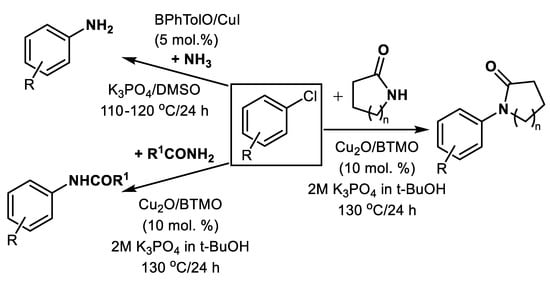
Scheme 97.
Arylation of NH
3
and amides using aryl chlorides catalyzed by Cu(I)/oxalamide complexes [
,
].
Instead of a harmful polar aprotic solvent such as DMF or toxic polar protic ethylene glycol, more sustainable biobased DMSO or low-toxicity alcohols such as ethanol or polyethylene glycols (PEGs) were used in many cases together with cheap bases such as K3PO4, KOH or K2CO3 in published methods (Table 1 and Table 2). The most expensive ingredient, auxiliary ligand, seems to still be an essential component for efficient conversion of tested aryl halides including aryl chlorides to the corresponding anilines in most cases. The possible recycling of used ligands, especially those based on oxalic acid diamides, is necessary for the potentially broad application of this type of dehalogenation method.
3. Cu-Catalyzed Substitution of Halogen in Ar-Xs with Primary and Secondary Amines
Instead of ammonia and its mentioned substitutes, a broad range of other nitrogen nucleophiles including aliphatic and aromatic amines, N-heterocycles, or amino acids can be used for the amination of Ar-Xs (Scheme 10Scheme 8). Interestingly, it was observed that amides and electron-rich azoles (pyrrole, imidazole or pyrazole) are more reactive than other amine substrates [54,55]. The observed increased reactivity of azoles and amides may be due to the faster reaction rates of Cu-azolate or Cu-amidate complexes in oxidative additions of Ar-Xs compared to other Cu-amino complexes, or due to the higher acidity of azoles and amides compared with other aliphatic or aromatic amines. On the other hand, more acidic polyazoles such as tetrazole exhibit low reactivity toward Cu-catalyzed C-N cross-coupling, likely due to their distinctive acidity and low N-nucleophilicity [54].
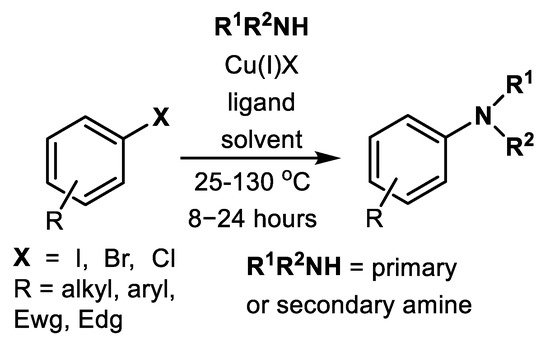
Buchwald’s research group developed polyamine-based ligands such as 1,2-diamines (N,N′-dimethylethane-1,2-diamine (DMEDA) or trans-N,N′-dimethylcyclohexane-1,2-diamine, DMCHDA) and (substituted) phenanthroline [56,57,58,59], Figure 2, Scheme 10Scheme 8.

Figure 2.
N,N-bidentate nucleophiles effective for Cu-catalyzed C-N cross-coupling [
,
,
,
,
].
DMEDA or DMCHDA were utilized together with CuI/K3PO4 for effective arylation of indoles using Ar-I and Ar-Br in boiling toluene [57].
In particular, DMCHDA was recognized as a very powerful ligand for arylation of azoles and diazoles in boiling toluene using CuI/K3PO4 as the commonly available reagents and applying Ar-I or even Ar-Br [56,57]. Aryl bromides Ar-Br were used for arylation of indazoles. However, the regioselectivity of N-1 arylation was significantly lower due to the slow oxidative addition of Ar-Br to the Cu-indazole complex, which is rearranged from the initially formed N-1 to the N-2 regioisomer [56]. Authors applied halide exchange protocols for converting Ar-Br to Ar-I [60,61,62] by using the action of NaI/CuI/diamine in boiling toluene for straightforward arylation of indazoles.
4,7-Dimethoxy-1,10-phenanthroline (DiMeOphen, Figure 2) was developed as a superior ligand for arylation of substituted imidazoles and benzimidazoles under relatively mild conditions [58,59].
Several in situ-produced enamine, oxime and hydrazone-based Cu(I) complexes (Figure 3) were described as highly effective for reactions between Ar-Xs and different electron-reach azoles even in boiling acetonitrile in co-action of Cs2CO3 at approximately 82 °C [63,64,65]. Additionally, salicylaldehyde-based oxime (SAO) or hydrazide (SAH) are simply available and cheap ligands that produce air-stable Cu(I)complexes and catalyze smoothly-described reactions of Ar-I and Ar-Br substituted with both electron-donating and electron-withdrawing functional groups.

Figure 3.
Imine, oxime or hydrazone-based ligands applicable for the production of air-stable Cu-catalysts [
,
,
,
,
,
].
Some amino acids such as proline or N,N-dimethylglycine were proved as effective bidentate auxiliary ligands for Cu-catalyzed C-N cross-couplings [66,67]. Besides the above-mentioned, amino acids possessing the primary amino group are simply arylated using both Ar-I and Ar-Br [65,66,68].
Generally, alkyl amines are more reactive in Cu-catalyzed N-arylation than anilines due to the stronger coordinating ability of the alkyl amine nitrogen compared to that of the aniline [23,54,69]. Using L-proline or N,N-dimethylglycine as the ligands, arylation of alkyl amines occurred at significantly lower temperatures compared with arylation of anilines [23].
Even at room temperature, the Cu-based C-N couplings were observed. Shafir and Buchwald described smooth C-N coupling of Ar-I and primary along with several secondary amines catalyzed with Cu(I) complexes produced in situ from CuI CuI (5%) and oxime-based ligand THQO, or 1,3-diketone-derived ligands CHXMK and CHXPrK (Figure 4). The mentioned room-temperature C-N coupling was performed in DMF using Cs2CO3 base within 2–4 h time period [69]. However, using aryl bromides, above mentioned arylation proceeds at 90 °C. Ar-Cls are inert toward tested amination. Two 1,3-dicarbonyl compounds-based ligands such as EtOCHXCARB or DPyPDON (Figure 4) were recognized as effective for Cu-catalyzed cross-coupling of different aromatic N-heterocycles and cyclic amide (pyrrolidone) with aryl iodides at mild reaction conditions [70,71]. Xi et al. prepared a catalytically active Cu-based complex via in situ reaction of 1,3-diketone DPyPDON and CuI for arylation of imidazoles by aryl bromides [70].
Cross-coupling of bulky aliphatic amine-based cross-partners was observed by Cook’s group using pyrrole-ol ligand stabilized by Hantzsch ester towards rapid degradation [72], Scheme 11Scheme 9.

Scheme 119.
Arylation of sterically hindered amines using even ortho-substituted Ar-I catalyzed by Cu/pyrolle-ol [
].
Usually, the inertness of aryl chlorides towards Cu-catalyzed N-arylations is the main limitation in the application of cheap Ar-Cls. The important exception to the inertness of Ar-Cls is a group of Ar-Cls activated by substitution with electron-withdrawing group(s) (Ewg). Mentioned chloroaromatics substituted with Ewg, especially chloronitrobenzenes, are activated for arylation of nucleophiles via SNAr2 reaction mechanism and react with amines even under catalyst-free conditions, Scheme 12Scheme 10 [73].

Scheme 120.
Arylation of nucleophile via S
N
Ar2 mechanism (the non-aromatic intermediate is stabilized by Ewg [
].
In addition, 2-Chlorobenzoic is another well-known and often applied Ar-Cl-based arylating agent containing a carboxyl group in the role of Ewg. However, 2-chlorobenzoic acid requires the application of a Cu-based catalyst for effective C-N cross-coupling [74,75,76,77].
Attempts were made to utilize effective bidentate ligands for arylation using non-activated aryl chlorides (chlorobenzene, chlorotoluene, etc.) under vigorous conditions in high-boiling polar aprotic solvents or in excess Ar-Cl used as both reagent and solvent.
Piperidine-2-carboxylic acid L-PIPA (Figure 5) was detected as a low-cost N,O-bidentate ligand applicable for amination, respective amidation of aryl chlorides in co-action of CuI in hot K2CO3/DMF mixture, although resulting in a low yield of corresponding anilides or anilines [78] (Scheme 13Scheme 11). Aniline and nitroaniline regioisomers were tested for amination of chlorobenzene. Surprisingly, diphenyl amine was obtained in the lowest yield (15%), 2-nitroaniline as the most reactive amine produces 31% of 2-nitrodiphenyl amine. Arylation of indole was tested with a comparable yield of 36%. Using acetamide, acetophenone was isolated in 24% yield. AO/RE mechanism was proposed for this reaction.
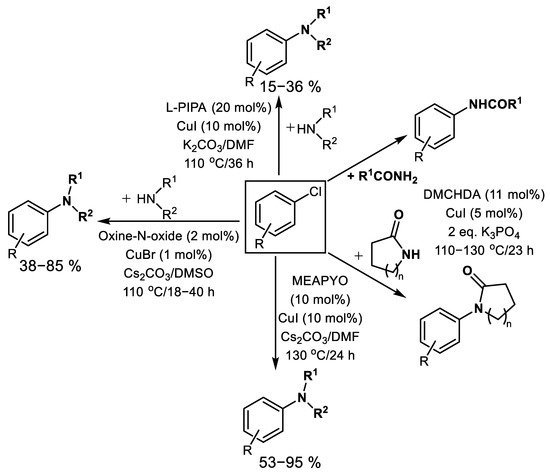
Scheme 131.
Published amination or amidation of Ar-Cls using different bidentate ligands and CuI [
,
,
,
,
].
N,N′-Dimethylcyclohexane-1,2-diamine DMCHDA (Figure 2) was proved to be an effective ligand for amidation of aryl chlorides used in excess as both arylation agents and solvent with the addition of CuI and K3PO4 at 130°C after tens of hours [79,80], Scheme 13Scheme 11.

Furthermore, 8-Hydroxyquinoline-N-oxide (Oxine-N-oxide, Figure 5) was described as a useful O,O-bidentate ligand for effective Cu-catalyzed amination of aryl chlorides using different primary and secondary aliphatic amines and five-membered N-heterocycles including pyrrole, imidazole, pyrazole, indole, 1,2,4-triazole [81], Scheme 13Scheme 11, Figure 5. The AO/RE mechanism depicted in Scheme 4 Scheme 2 was suggested for this reaction.
Recently, a new complex produced in situ from 2-mesitylamino pyridine-1-oxide (MEAPYO, Figure 5) and CuI was discovered as an available catalyst for efficient amination of aliphatic primary and secondary amines [82]. Liu et al. described CuI/MEAPYO as effective even for C-N coupling of nonactivated aryl chlorides [82]. Using primary amines or less sterically hindered secondary amines, different aryl chlorides produce corresponding arylated amines using 5–10 mol.% CuI and 5–10 mol.% of MEAPYO under heating at 130 °C in DMF using Cs2CO3 as the base under argon [82]. However, when using more bulky secondary amines (such as N-benzyl-N-methylamine or N-methylpiperazine), incomplete conversion (and lower yield 53–59%) is observed [82], Scheme 13Scheme 11.
In addition to the above-mentioned, Ma´s research group searched for active ligands based on oxalamide derivatives for N-arylation, based on aryl chlorides application [8,47,83,84]). De et al. assumed that furane and thiofene ring moiety bound in oxalamide skeleton (BFMO and BTMPO ligands, Figure 6) are very effective ligands applicable for C-N couplings between aryl chlorides and different N-nucleophiles such as amides and secondary amines, including heterocyclic ones [47].

Figure 6.
Structures of another highly effective oxalic acid diamide- and benzoin oxime-based ligands [
,
,
,
].
Primary and secondary amines react smoothly with aryl bromides and iodides using even highly catalytic (0.1 mol.% Cu2O and ligand, over 10,000 turnovers) conditions when applying a 1-naphtylamine-based oxalic diamide such as MNBO (N-(2-methylnaphtalen-1-yl)-N′-benzyl oxalamide (Figure 6) in boiling KOH/EtOH mixture under inert after 12 h of action [44].
The weakly-activated polyaromatic chlorides such as 1-chloroanthraquinone react smoothly with aromatic amines so long as a stochiometric quantity of powdered copper is added. This reaction is broadly used in anthraquinone-based dye and pigment production. Zhang et al. improved this methodology using only a catalytic amount of CuI (10 mol.%) in hot N,N-dimethylformamide using cheap K2CO3 as the base without the necessity of adding another ligand [85], Scheme 14Scheme 12.

Scheme 14.
Synthesis of anthraquinonoid dyes intermediates via amination of 1-chloroanthraquinone [
].

